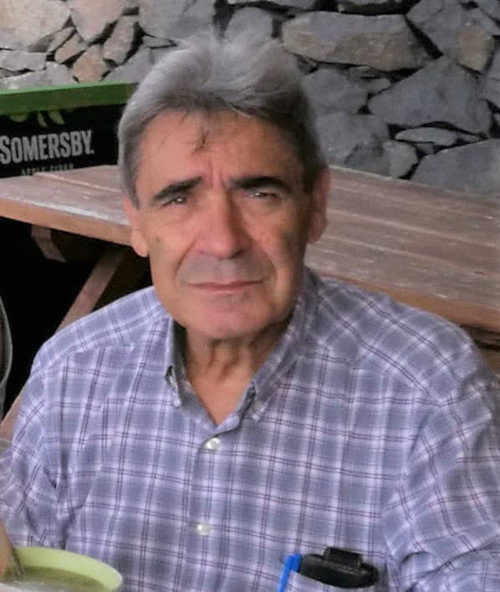 Jesús Gómez González, 2017 (Photo courtesy of Pablo De Vicente)
Jesús Gómez González, 2017 (Photo courtesy of Pablo De Vicente)
Jesús Gómez González
Contributed by Pablo De Vicente
Jesús Gómez González was born in Madrid, Spain, in 1948. He studied at the Universidad Complutense de Madrid and obtained his doctorate in Physical Sciences in 1974. From the University Complutense, where he was associate professor, he went to the Paris-Meudon Observatory and the National Radio Astronomy Observatory of the United States in Charlottesville, Virginia, to gain experience in radio astronomy, a science that did not exist in Spain at that time. During his stay in these two places, between the 1971-1974 period, he worked on his doctorate.
On his return to Spain, he was commissioned by the National Geographic Institute (IGN) to carry out the pioneering work of installing, commissioning, and operating the first Spanish radio telescope, a 14m dish, in a new observatory to be built in Yebes (Guadalajara). This task also included the coordination of a team to carry out scientific research and instrumental development. His vision was to create a group of skilled astronomers and engineers in Yebes, who would carry out world-class research and instrumentation in radio astronomy. This vision came to reality and today Yebes hosts a complete radio astronomy infrastructure with telescopes and laboratories and there is a highly competent group of astronomers and engineers at the IGN.
During the second half of the seventies, he developed close contacts with the consortium that would create IRAM (Institute of Milimeter Radio Astronomy). After being very active in the organisation of the local facilities in Granada he became a deputy director of the IRAM 30m telescope during its first years of operation. In the late eighties Jesús was a driving force in making IGN a full partner of IRAM. He was a member of the IRAM SAC for several years and a member of the IRAM executive council for more than twenty years.
Jesús was convinced early on the importance of Very Long Baseline Interferometry (VLBI) as a radio astronomy technique both for astronomical research and as a tool for obtaining an accurate terrestrial reference frame. He worked first to create a technical team that understood this technique and could implement it at Yebes Observatory and later to include the 14m radio telescope in the European VLBI Network (EVN) and in the International VLBI Service (IVS). This was achieved in the 1990s. Jesús also supported the creation of the Joint Institute for VLBI (JIVE) whose main objective was to provide correlation to the EVN, and he was a member of the JIVE Board, later Council, from 1994 to 2017. Currently the Yebes Observatory participates in several VLBI networks with its 40m and 13.2 m radio telescopes fulfilling Jesús' dreams.
He became Director of the National Astronomical Observatory and later Deputy Director General of Astronomy, Geophysics and Geospatial Applications. During this period, he promoted the construction of the 40m radio telescope at Yebes Observatory and the creation of RAEGE, an array of VLBI stations in Spain and Portugal, to carry out geodetic studies. He also developed a plan to reorganise the Royal Observatory of Madrid (ROM), which included the construction and installation of a new museum of Earth and Universe Sciences and a 1:1 scale reconstruction of the Observatorio Astronómico Nacional famous 25-foot Herschel telescope from the 18th century.
Jesús retired in June 2017, and he died on 3 January 2024 after a long period of illness. During his retirement he maintained a close relationship with the Yebes Observatory to which he dedicated a large part of his professional life. He was always very interested in all the technical developments and was able to see the centre grow from its beginnings, when he was entrusted with its operation in 1974, to an internationally recognised observatory and technology centre in radio astronomy.
![[IAU logo]](iau_wb_thumb.jpg)
![[URSI logo]](URSI-logo-thumb.jpg)
![[Karl Jansky at his antenna]](jansky_photo_02_thumb.jpg)
![[Reber's Wheaton antenna]](Reber_Telescope_Wheaton_thumb.jpg)
![[Dover Heights]](Dover_Heights_02_thumb.jpg)
![[4C telescope]](GB61-195_4C_telescope_thumb.jpg)
![[Ewen and horn antenna]](ewen_horn1s.jpg)
![[Dwingeloo, 1956]](Dwingeloo-1956-thumb.jpg)
![[Jocelyn Bell Burnell and Cambridge antenna used in pulsar discovery]](burnell2_thumb.jpg)
![[Lovell Telescope at Jodrell Bank]](site_1594_0001-500-334-20180316163019-thumb150.jpg)
![[Wilson, Penzias, and Bell Labs horn antenna]](wilson-penzias-horn_thumb.jpg)
![[6-m Millimeter Radio Telescope in Mitaka, Japan]](6m-thumb.jpg)

